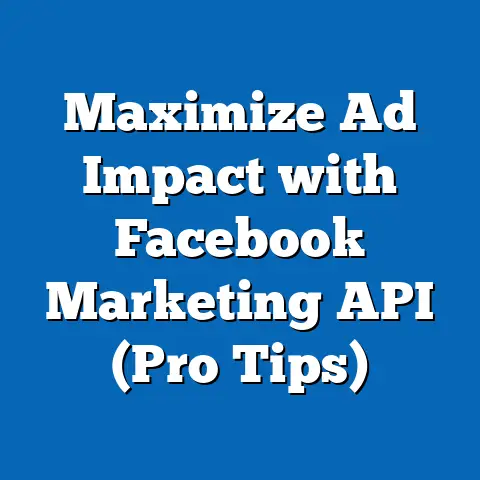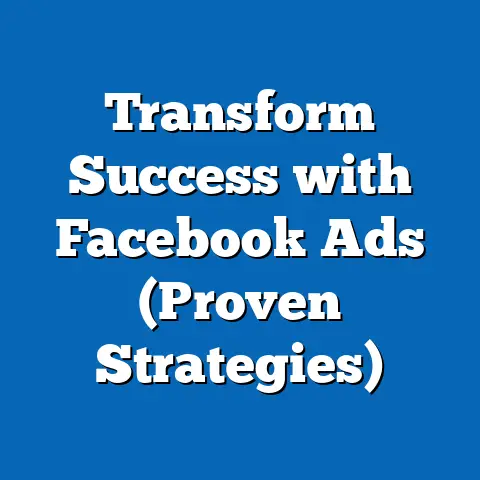Maximize Engagement with Facebook & Insta Ads (Pro Tips)
In the ever-evolving landscape of digital marketing, the comfort that modern generations find in social media platforms like Facebook and Instagram is a pivotal factor in crafting effective advertising strategies. This comfort is not merely a preference but a deep-seated behavioral trait shaped by technological advancements, cultural shifts, and economic realities. For many, particularly Millennials and Gen Z, these platforms are not just tools for connection but extensions of their social identities, making them fertile ground for targeted advertising.
Section 1: The Comfort of Social Media Across Generations
Defining Characteristics of Comfort in Digital Spaces
Comfort in the context of social media usage refers to the ease and familiarity that users, particularly younger generations, feel when navigating platforms like Facebook and Instagram. This comfort manifests as an intuitive understanding of platform mechanics, a willingness to share personal information, and a reliance on these spaces for news, entertainment, and social interaction. For Millennials (born 1981–1996) and Gen Z (born 1997–2012), social media is often a primary mode of communication, with 90% of Gen Z using platforms like Instagram daily, according to a 2022 Pew Research Center study.
This comfort is not universal across all demographics, however. Older generations, such as Baby Boomers (born 1946–1964) and Gen X (born 1965–1980), may approach social media with more caution, often due to concerns about privacy or a lack of digital nativity. Understanding these generational differences is crucial for advertisers aiming to tailor their strategies effectively.
Historical Context Shaping Digital Comfort
The rise of social media in the early 2000s, with platforms like MySpace and the launch of Facebook in 2004, coincided with the coming-of-age of Millennials, who became the first generation to grow up with widespread internet access. The introduction of smartphones in the late 2000s further accelerated this shift, embedding social media into daily life. For Gen Z, born into a world where social media was already ubiquitous, platforms like Instagram (launched in 2010) became central to their social and cultural development.
Significant events, such as the 2008 financial crisis, also played a role in shaping digital comfort. Millennials, many of whom entered the workforce during this economic downturn, turned to social media for networking and job opportunities, further integrating these platforms into their lives. Meanwhile, Gen Z’s exposure to global issues like climate change and social justice through viral campaigns on Instagram has made them adept at using these tools for advocacy and community building.
Societal Implications of Digital Comfort
The societal impact of this comfort with social media is multifaceted. On one hand, it has democratized information access and fostered global connectivity, allowing brands to reach diverse audiences with unprecedented precision. On the other hand, it has raised concerns about mental health, with studies like those from the American Psychological Association (2021) linking excessive social media use to anxiety and depression among younger users.
Moreover, the comfort younger generations feel with social media has shifted expectations around advertising. Traditional, interruptive ads are often met with resistance, while authentic, value-driven content tends to resonate more. This dynamic has profound implications for how marketers approach engagement on platforms like Facebook and Instagram, necessitating strategies that align with users’ digital comfort zones.
Section 2: The Importance of Engagement in Social Media Advertising
Why Engagement Matters
Engagement—measured through likes, comments, shares, and clicks—is the lifeblood of social media advertising. Unlike traditional metrics like impressions, engagement reflects an active interaction between the audience and the brand, indicating a deeper level of interest or emotional connection. A 2023 report by Hootsuite found that posts with high engagement rates on Instagram can increase brand visibility by up to 300% due to algorithmic boosts.
For advertisers on Facebook and Instagram, engagement is not just a vanity metric but a driver of campaign success. Higher engagement often translates to lower cost-per-click (CPC) rates and improved ad relevance scores, as these platforms prioritize content that resonates with users. Understanding how to maximize engagement is, therefore, a critical skill for modern marketers.
Generational Nuances in Engagement Patterns
Engagement behaviors vary significantly across generations, reflecting their differing levels of comfort with social media. Gen Z, for instance, is more likely to engage with short-form video content on Instagram Reels, with 60% of users aged 18–24 reporting daily interaction with this format (Statista, 2023). Millennials, meanwhile, often engage with content that aligns with their values, such as sustainability-focused campaigns or community-driven initiatives.
Older generations like Gen X and Baby Boomers, while less active overall, tend to engage with content that offers practical value, such as tutorials or product reviews on Facebook. Marketers must tailor their strategies to these preferences, ensuring that content format, tone, and messaging align with the target demographic’s digital comfort and expectations.
Section 3: Pro Tips for Maximizing Engagement with Facebook & Instagram Ads
1. Leverage User-Generated Content (UGC) for Authenticity
One of the most effective ways to build trust and engagement is by incorporating user-generated content into ad campaigns. UGC, such as customer photos or testimonials, resonates with audiences because it feels authentic rather than overly polished or corporate. A 2022 study by Stackla found that 79% of consumers say UGC highly impacts their purchasing decisions.
To implement this, brands can encourage followers to share content using branded hashtags and feature this content in their ads. For example, a fitness brand might run an Instagram campaign asking users to post workout videos with a specific hashtag, then repurpose the best submissions in their paid ads. This strategy not only boosts engagement but also fosters a sense of community among users.
2. Optimize for Mobile-First Experiences
Given that 98% of Instagram users access the platform via mobile devices (Oberlo, 2023), designing ads with a mobile-first mindset is non-negotiable. This means prioritizing vertical formats like Stories and Reels, ensuring fast load times, and using bold visuals that capture attention within the first three seconds. Text should be minimal and easy to read on small screens, with clear calls-to-action (CTAs) like “Swipe Up” or “Shop Now.”
Mobile optimization also extends to targeting. Instagram’s algorithm favors ads that perform well on mobile, so testing different creative formats and monitoring engagement metrics is key. For instance, carousel ads often outperform single-image ads on mobile, as they allow users to swipe through multiple visuals or messages.
3. Utilize Advanced Targeting and Lookalike Audiences
Facebook and Instagram offer robust targeting tools that allow advertisers to reach highly specific audiences based on demographics, interests, and behaviors. For generational campaigns, this means segmenting audiences by age, location, and online habits to deliver tailored content. A 2023 report by Social Media Today found that hyper-targeted ads can increase click-through rates (CTR) by up to 50%.
Lookalike audiences are another powerful tool, enabling brands to reach new users who share characteristics with their existing customers. By uploading a customer list or leveraging pixel data, marketers can create lookalike audiences that mirror the digital comfort and engagement patterns of their best-performing segments. This is particularly effective for reaching younger demographics like Gen Z, who are often harder to pin down through traditional targeting.
4. Experiment with Interactive Ad Formats
Interactive ad formats, such as polls, quizzes, and augmented reality (AR) filters, are highly engaging because they invite active participation. Instagram Stories, for example, allow brands to add polls or “Swipe Up” links that encourage immediate interaction. A 2022 Meta study found that interactive ads on Instagram generate 20% higher engagement rates compared to static ads.
For instance, a beauty brand might create an AR filter that lets users “try on” lipstick shades, encouraging them to share the experience with friends. Such formats not only boost engagement but also align with the playful, exploratory nature of younger users’ digital comfort. Testing different interactive elements can help identify what resonates most with specific generational cohorts.
5. Prioritize Video Content for Higher Engagement
Video content consistently outperforms other formats on both Facebook and Instagram, especially among younger audiences. According to HubSpot (2023), video ads on Instagram receive three times more engagement than image-based ads. Short-form videos, such as Instagram Reels or Facebook Stories, are particularly effective for capturing attention in a crowded feed.
When creating video ads, focus on storytelling that aligns with generational values. For Millennials, this might mean highlighting a brand’s social impact, while Gen Z might respond better to humor or trending challenges. Additionally, ensure videos are optimized for sound-off viewing by including captions, as 85% of social media videos are watched without sound (Digiday, 2022).
6. Time Your Ads for Maximum Impact
Timing plays a critical role in engagement, as different generations are active on social media at different times. Data from Sprout Social (2023) indicates that Gen Z is most active on Instagram between 6 PM and 9 PM, while Millennials often browse during lunch hours (12 PM–2 PM). Scheduling ads to align with these peak times can significantly boost visibility and interaction rates.
Beyond daily timing, consider seasonal trends and cultural events. For example, running holiday-themed campaigns or leveraging viral moments can tap into heightened user activity. A/B testing different posting schedules can provide actionable insights into when your specific audience is most receptive.
7. Focus on Value-Driven Messaging
Modern consumers, especially younger generations, are increasingly skeptical of overt sales pitches. Instead, they engage with content that offers value—whether through entertainment, education, or emotional connection. A 2023 Edelman Trust Barometer report found that 67% of consumers are more likely to engage with brands that demonstrate social responsibility in their messaging.
For Facebook and Instagram ads, this means crafting campaigns that prioritize storytelling over hard sells. A sustainable fashion brand, for instance, might create a series of ads highlighting the environmental impact of fast fashion, paired with a CTA to shop eco-friendly alternatives. Such messaging aligns with the values of Millennials and Gen Z, fostering deeper engagement.
8. Monitor and Adapt with Analytics
Finally, maximizing engagement requires a commitment to data-driven decision-making. Both Facebook and Instagram provide detailed analytics through their Ads Manager platforms, offering insights into metrics like reach, engagement rate, and conversion. Regularly reviewing these metrics allows marketers to identify high-performing content and adapt underperforming campaigns in real-time.
For example, if a video ad targeting Gen Z shows low engagement, testing a different thumbnail or CTA might yield better results. Similarly, if an ad resonates strongly with Millennials but not Gen X, segmenting the audience further can optimize outcomes. Continuous monitoring ensures that strategies remain aligned with evolving user behaviors and platform algorithms.
Section 4: Societal and Cultural Implications of Social Media Advertising
Shaping Consumer Behavior Across Generations
The strategies outlined above do more than drive engagement; they also influence broader societal trends. Social media advertising has reshaped how generations perceive brands, with younger users often equating a strong digital presence with credibility. This shift has forced businesses to prioritize transparency and authenticity, as any misstep can quickly go viral and damage reputation.
Moreover, the focus on personalized, value-driven content reflects a cultural move toward individualism and ethical consumption. Gen Z, in particular, holds brands accountable for their social and environmental impact, a trend amplified by the visibility of campaigns on platforms like Instagram. Marketers must navigate this landscape carefully, balancing commercial goals with societal expectations.
Workplace and Economic Impacts
The emphasis on digital advertising has also transformed the marketing industry, creating demand for roles like social media managers and content creators. For younger generations entering the workforce, proficiency in platforms like Facebook and Instagram is often a prerequisite, reflecting their digital comfort. Economically, the social media ad market is projected to reach $207 billion by 2028 (Statista, 2023), underscoring its significance as a driver of growth and innovation.
However, this rapid evolution also raises challenges, such as the digital divide between generations. Older workers or small businesses with limited digital literacy may struggle to keep pace, potentially widening economic disparities. Addressing these gaps through education and accessible tools will be critical for inclusive growth.
Ethical Considerations in Targeted Advertising
The power of targeted ads on Facebook and Instagram comes with ethical responsibilities. Issues like data privacy and algorithmic bias have sparked debates about the societal impact of social media advertising. A 2021 Pew Research Center survey found that 74% of Americans are concerned about how platforms use their personal data, a sentiment shared across generations but particularly strong among Gen Z.
Marketers must prioritize ethical practices, such as obtaining explicit consent for data usage and ensuring transparency in ad targeting. Failure to do so risks eroding the very comfort that makes social media such a powerful advertising medium, potentially leading to regulatory backlash or consumer distrust.
Section 5: Conclusion and Forward-Looking Insights
Maximizing engagement with Facebook and Instagram ads requires a deep understanding of generational comfort with social media, coupled with strategic creativity and data-driven optimization. By leveraging authentic content, interactive formats, and precise targeting, marketers can tap into the digital behaviors of diverse audiences, from tech-savvy Gen Z to value-conscious Millennials. The tips provided—ranging from mobile optimization to value-driven messaging—offer a roadmap for navigating this dynamic landscape.
Looking ahead, the future of social media advertising will likely be shaped by emerging technologies like artificial intelligence and virtual reality, which could further personalize and immerse users in ad experiences. However, uncertainties remain, including potential regulatory changes around data privacy and the evolving preferences of younger generations like Gen Alpha (born 2013–present). Marketers must stay agile, continuously adapting to technological and cultural shifts while maintaining an ethical compass.
Ultimately, the intersection of generational dynamics and digital advertising presents both opportunities and challenges. By fostering genuine connections and respecting user comfort, brands can build lasting engagement on platforms like Facebook and Instagram, contributing to a more connected and responsive digital ecosystem. As societal expectations evolve, the ability to balance innovation with responsibility will define the next era of social media marketing.






